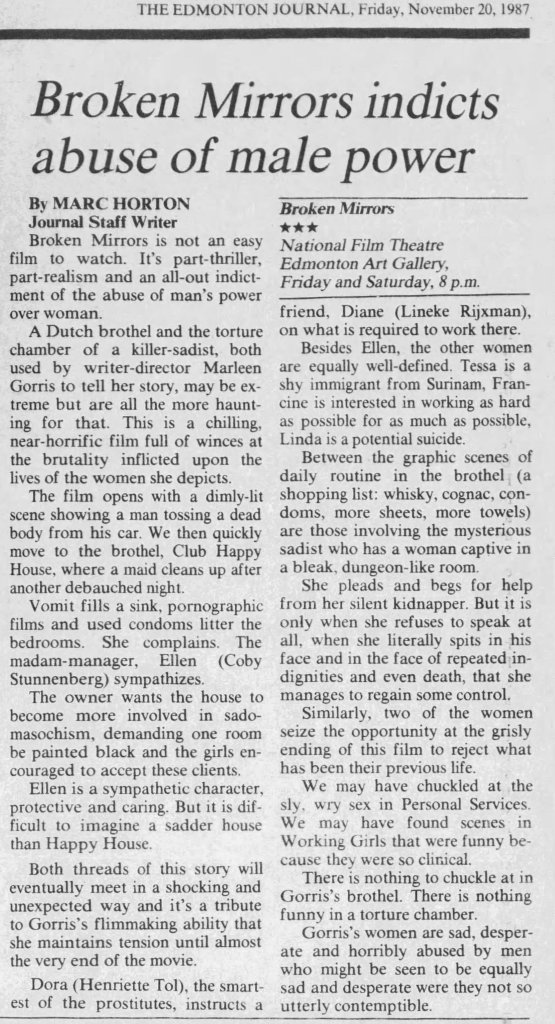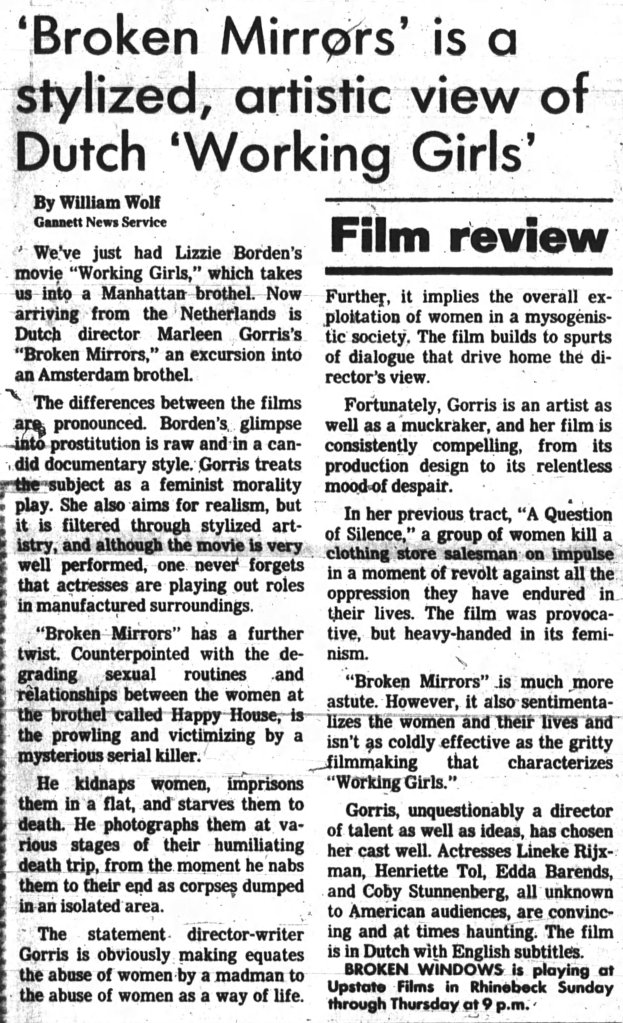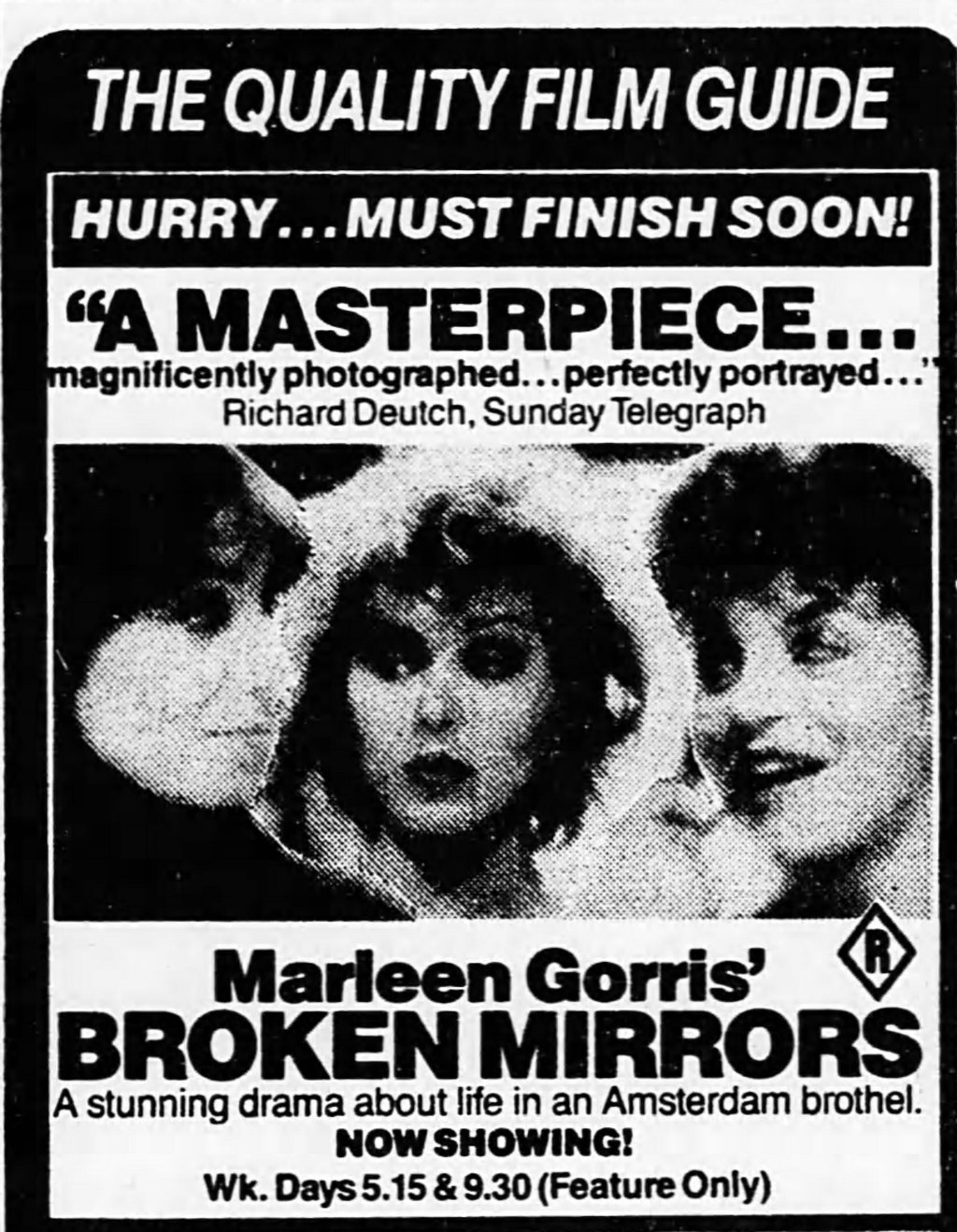
Cult Epics continues its reign as the premiere distributor of classic Dutch films on HD in the States with their second Marleen Gorris title, the 1984 film Broken Mirrors (Gebroken spiegels). Arriving two years after her theatrical debut, A Question of Silence, and one year after her television short film, De geest van gras, Broken Mirrors solidified Gorris as one of the most daring and serious filmmakers of her generation.
Scripted by Gorris, Broken Mirrors is a brutal and uncompromising film set mostly in a Dutch brothel in the early eighties. Alternately a murder mystery and a stark near documentary look at the life of Dutch prostitutes in the period, Broken Mirrors like A Question of Silence utilizes its story to question the longstanding patriarchy that continues to hurt women all over the world. Not an easy film to watch, Broken Mirrors is a real gun blast to the face and Gorris envelopes the audience into the film’s depressing and ugly world from the first frame on.
Sex work has long been utilized as a plot point for countless numbers of films since the dawn of cinema. Almost exclusively presented from a male viewpoint by male filmmakers, the film world has often demonized the profession to where it has gone hand in hand with continued cruel laws surrounding it. Unlike the endless stream of works that have filled theaters fixated on the idea of sex work and workers, Broken Mirrors is told completely from the female point of view and pulls no punches in presenting man’s inherent ugliness in the shadowy industry.
A Question of Silence had been an absolute grand slam of a debut, so it is no surprise to find Gorris working with many of the same crewmembers for Broken Mirrors. Producer Matthijs van Heijningen, composer Lodewijk de Boer, cinematographer Frans Bromet, and editor Hans van Dongen all again return for the follow-up to one of the finest films any of them made in their distinguished careers. For Broken Mirrors, Bromet’s work proved vital as his photography matches the film’s adventurously caustic feel throughout.
Cast-wise, several holdovers from A Question of Silence returned for Broken Mirrors including Henriëtte Tol and Edda Barends. New to Gorris film world were talented actresses: Lineke Rijxman, Coby Stunnenberg and Carla Hardy, all of whom deliver superb, unforgettable performances that don’t feel like performances at all. There is a pulverising authenticity to Broken Mirrors and each actress Gorris cast creates completely unforgettable characters that are hard to shake well after the credits have rolled.
While Broken Mirrors, like A Question of Silence, is very much an ensemble piece, relative newcomer Lineke Rijxman has the film’s most essential and unforgettable role as Diane, the novice prostitute that we watch change and finally explode causing one of the most haunting cinematic conclusions of the eighties.
Lineke Rijxman delivers such a measured, studied and brilliant performance in Broken Mirrors it’s hard to believe that it was one of her very first films. A couple of television roles aside, Rijxman’s only big screen portrayal prior to Broken Mirrors was in Ben Verbong’s tremendous 1981 feature The Girl With the Red Hair (Het meisje met het rode haar), another female-centric Dutch film from the period. An accomplished stage actress as well, Rijxman’s work in Broken Mirrors is quietly astonishing and there is never a hint of inexperience. The film kick-started a prolific career in film, television, and on stage and Gorris never forgot her as her role as the narrator of her Oscar-winning Antonia’s Line (1985) showed.
A lesser filmmaker than Gorris would have focused their attention more on the male serial killer that appears in Broken Mirrors, but Gorris uses what could have been just a pulpy plot Point as a harsh rebuttal of man’s treatment of women. Broken Mirrors could have easily devolved into just another murder mystery with prostitution used just for titillation, but Gorris’ art is definitely feminist in both its themes and styles.
Like A Question of Silence, the Dutch press covered Broken Mirrors prominently in the days leading up to its release. Producer van Heijningen described the film as a “social psychological thriller” to a reporter selling the film’s feminist themes short. It was Gorris’ unwavering dedication to her art and political beliefs that drove most of the coverage even down to a lengthy NRC Handelsblad profile of customer Jany Hubar who noted, “the script by Marleen Gorris is accompanied by ten pages of homework for me, in which she describes what everyone should look like” showing Gorris as being involved in every aspect of her film.

Columnist Constant Wallagh penned a lengthy pre-release look at Broken Mirrors at the end of 1983 in the paper Algemeen Dagblad noting the film represented a change from the “so-called romance of the plush brothel of yesteryear” and that it “has given way to an efficient, albeit hard-hitting sex business.” Writing on the importance of the film’s location and look, Wallagh pointed out,
“An important part of the film Broken Mirrors is made in a dilapidated building on the Prinsengracht in Amsterdam. Under the watchful eye of producer Matthijs van Heijningen, the interior of the Happy House sex club was built there. Of course, there are the narrow and steeply rising stairs that, according to tradition, lead from the bar to an upper floor, straight to the pink, blue and green rooms of the girls present for this purpose. In order to have as much photographic freedom of movement as possible within the dark red brothel walls that leave him little space, Frans Bromet carries his camera on his shoulder. The walls are full of long mirrors and the low tables with stimulus reading are put in a ruddy light by popping twilight lights.”
The detailed Algemeen Dagblad piece also included interviews with a handful of people on the set of Broken Mirrors:
“Coby Stunnenberg (she played one of the leading roles in Jos Stelling’s The Pretenders) points out the usefulness of the dry rehearsals that preceded the recordings. “Marleen Gorris has devoted a lot of time and thorough attention to this. Everyone talked to her individually about the scenario and their own role. With the entire team, we spent another day in an existing brothel. Even the humor is not lacking, Of course, the social drawing of the environment is by no means optimistic. But fortunately there is no muscle of romance in this narrative that shows very sharply the various motives of the women. Some engage in prostitution out of sheer greed, for others it has become a kind of habit of life.” The only male lead — owner of the sex club — Johan Leyssen sees something else in the background of this film. “I see a brothel like the one in Broken Mirrors as a form of imagery for what can actually happen between men and women,” he says.”
Broken Mirrors release coincided with a prolific period for Dutch film. NRC Hadelsblad pointed out that “during the past year, a record number of seventeen full-length Dutch feature films were in circulation” calling it an absolute “tidal wave” of mostly quality features.
Despite the astonishing number of great films coming out of Holland in the early eighties, international markets and festivals remained elusive. Nieuwsblad van het Noorden called out The Venice Film Festival in the fall of 1984 for rejecting all the Dutch entries including Broken Mirrors which caused a considerable rift for the festival as the paper included:
“Marleen Gorris’ Broken Mirrors (the final film of the Dutch Film Days in a month’s time) was also seen and found unsuitable. Festival director Luigi Rondi (himself a critic) seems to have been sickened by this feminist brothel drama in which a lust killer receives detailed attention. Producer Matthijs van Heijningen confirms the incident with the impassive festival director.”
It was an overtly sexist act by the Festival and Rondi, especially considering how successful A Question of Silence had been. Gorris remained defiant and undeterred in the face of cinema’s institutionalized misogyny. A long profile piece in NRC Handelsbald in the wake of the Venice Film Festival debacle featured Gorris calling herself a feminist filmmaker who still felt very much on the outskirts of the mostly male Dutch film community:
“I always look like a lady with a raised finger. It quickly becomes moralizing.”In that very small world, they know my name now, I believe. But I have little contact with colleagues and for some reason I always miss the meetings of the Society of Dutch Feature Filmers. We never talk to each other so intensively.”
Asked if she felt a kinship to the crew that she was using for a second time in Broken Mirrors, Gorris stated,
“I have certainly experienced that familiarity with some of them, especially with cameraman Frans Bromet. You always have to listen closely, because he says so little. I still know little about technology; The different lenses have been explained to me ten times, but I keep forgetting it. I’m probably too old to learn that, but maybe I just don’t care enough. It doesn’t bother me much. I make image frames together with Frans, and that usually goes well. It is more important that the technicians, also from the laboratories, understand me than that I can always follow them.”
Gorris was determined to top her impressive first film, noting,
“I hope so. It is more accomplished, because of course I’ve learned something.” One of the things I didn’t necessarily want was for the sex club to look like the civilian man imagines a brothel: chic, beautiful, big, opulent. In the research phase, it turned out that these clubs look very petty-bourgeois and made of plastic. We have also done everything to create an impression of smallness, but that is not easy on location. I would have preferred to shoot the film in a studio, but that seems to be too expensive.” Why did you want to make a film about prostitution? “I had been planning something like this for a long time, and I tried it in 1978, when I worked at the Amsterdams Stadsjournaal. I then discovered that I am not suitable for making documentaries. Why prostitution? I may want to show that prostitution is not an isolated phenomenon, but part of a society in which there is a fundamental power difference between men and women.”
Confronted by the reporter about the fake power sometimes given to prostitutes in the film, Gorris recalled,
“”Yes, but that’s sham power. A prostitute can say: I decide what happens, but the framework in which they pay and deliver is not determined by them.” In principle, there is nothing against prostitution, if it is a power game between men and women. “You should say: there’s basically nothing against sex. If that were looked at less strangely, the game would also become more equal. You can say that prostitution is attractive to some men because it involves anonymity, but the women are not anonymous. Whores are considered inferior, by society and by themselves.’ Is it because they are women? “Yes.” But what about gay prostitution? “Should we talk about that now? That’s a whole other story, connected to the sexual morals. It also takes place in secret.’”
Questioned about her use of sexuality in both of her early films the NRC Handelsblad piece asked Gorris about the increasing availability of harcore pornography. “”I do know that over the years, porn has evolved from witty sexual stuff to something frightening and violent. Child pornography and child abuse have skyrocketed. Something new are also the American serial killers, who seek their victims among women and children. It looks like everything is hardening.”
Questioned about how overwhelmingly depressing the film was and if audiences at all found the shocking conclusion at all cathartic, Gorris pointed out,
“In a number of previews, I have noticed that people come out of it excited, very impressed. I have nothing against that. But they also see how someone goes through a development, and come out of it. One of the prostitutes decides to get out, and shoots her reflection to pieces. My previous film also had such catharsis, the laughter in the courtroom, and then the effect in the room was usually cheerful. In my new film, a sad feeling lingers, even after the catharsis. Yet the solution in A Question of Silence was destructive, and in Broken Mirrors comes the insight without breaking anything except the image that the woman has of herself, and that society has of her. I think that’s hopeful, and constructive.”
Appearing on the same page as the long Gorris interview was a similar piece and chat with actress Henriëtte Tol, who exclaimed that Broken Mirrors was very much a film for both women and men and that her first viewing of it left her shaking in her seat because it was so “poignant and exciting”. Disappointed about the Venice Film Festival, she mentioned that the film was exceedingly hard to watch and could make certain audience members sick to their stomachs.
A later interview in the same paper featured a more frustrated Gorris exclaiming that she was tired of having to explain the film and that she considered having to do so a failure on her part as the film should do that itself. Asked about the film’s icy themes,
“What matters to me is to give a picture of the balance of power within society. And that can be found in an extreme form in the brothel. The other line in the film is an extreme metaphor of those power relations. The film is about the behavior of a certain kind of men, and that’s revealing and pretty clear I thought,”

Broken Mirrors would finally premiere in the fall of 1984 at a film festival in Sylvia Kristel’s hometown of Utrecht, where it would close out the week-long event. Reviews in the Dutch press were mostly strong, with the voices of dissent being mostly male. Like A Question of Silence, the film caused much discussion amongst both critics and audience members. Even the few dissenting voices admitted how well made and acted the film was and that it was surprising it hadn’t won the Golden Calf award.
International deals soon followed and Gorris once again found herself in the unique position of being a Dutch filmmaker finding success amongst English language markets, as the film had high-profile runs throughout England and America. Like A Question of Silence, Broken Mirrors also played at several English language film festivals, including a high-profile screening at the San Francisco International Film Festival.

English language critical reaction to Broken Mirrors was also fairly strong, although uniformly each pointed out how difficult it was to watch. Reviews of the film regularly featured words like ‘harrowing’, ‘relentless’, ‘brutal’, and ‘chilling’. Much of the attention focused on the film’s overtly feminist message and its hyper-realism proved especially shocking to unsuspecting audience goers raised on ‘hooker with a heart of gold’ films that American cinema has particularly profited in.
Broken Mirrors continued its successful theatrical run throughout various international markets well into the late eighties before several home video versions appeared. Despite these early releases, Broken Mirrors hasn’t been available for years, making Cult Epics’ new Blu-ray especially valuable.
The high-profile runs of both A Question of Silence and Broken Mirrors were surely overwhelming for Gorris, who was still just in her thirties during this period. The trailblazing filmmaker took a well-deserved break after Broken Mirrors and more than half a decade passed before the release of her next film, 1990s The Last Island (also coming soon from Cult Epics).
Cult Epics’ recent Blu-ray of Broken Mirrors includes a brand new 4K HD Transfer (from the original 35 negative) & Restoration marking the best Gorris film has looked since its original theatrical run decades ago. Like several Cult Epics other Dutch releases, an informative audio commentary track by Film Scholar Peter Verstraten is on hand as is a promotional gallery. Also included is a fascinating vintage Dutch television interview with US Sex Worker Margo St. James which finds Broken Mirrors and Gorris brought up during the enthralling discussion.
Broken Mirrors is now available everywhere physical media is sold, as well as directly from Cult Epics where a limited run number ships with a collectible postcard. We are experiencing a real renaissance in Dutch film history and Cult Epics remains at the forefront in getting these groundbreaking films to an English language market.
-Jeremy Richey, 2023-
Here are a selection of vintage English language notices I have collected about the film:











Leave a comment